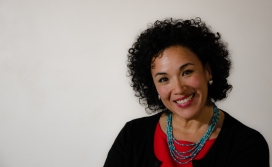 Interview with Martha Acosta, Instructional Designer, Learning Consultant, and Instructor about her business, experience, and take aways from ChallengeHER in Albuquerque, NM.
Interview with Martha Acosta, Instructional Designer, Learning Consultant, and Instructor about her business, experience, and take aways from ChallengeHER in Albuquerque, NM.
1. Tell us a little about your business and its mission.
Martha: I have had a business as a leadership and organizational learning consultant since 2007 and I have been in the training field for about 20 years in total. I am an instructional designer and I also instruct. I’ve been working on my own for several years now and I just started building my company and hiring people.
My freelance work started out with a contract for Cisco Systems, which then led to contracts with Intel and Harvard Business Publishing, where I work as a contractor and do a lot of leadership training for banks, and large multinationals like General Motors and Colgate through them.
My organization’s mission is to help improve learning within organizations and my academic specialty is in leadership and organizational learning. For Harvard I teach a full range of subjects from the MBA curriculum.
Within federal government my specialty is in the safety leadership area.
Before I started working on my own, I was a training manager at Los Alamos National Laboratory in New Mexico where I led a team that delivered safety training and responded to safety incident corrective actions. It is a passion of mine to help organizations deal with failure.
- How difficult was the move to self-employment and becoming an independent contractor?
Martha: It was quite tough, from the beginning I even regretted leaving (who leaves a government job, right?). But then I managed to score a contract in Silicon Valley which was a gift to my business. My day rate tripled since I started which would never have happened in regular employment. I learned to love the freedom and many income opportunities I can create for myself. But it also came with many lessons learned such as the need to manage my cash flow to cover for seasonal variation so I had to start thinking about my income differently.
- Have you always planned on doing business with the federal government?
Martha: I wanted to grow my business which was difficult to do due to my narrow specialty and freelancer status. People wanted to hire just me as an expert so it was difficult to start building a team around me to form a company.
I believe that the contract with the U.S. Forest Service which I just signed will give me the opportunity to work with more people on a larger scale.
- What shaped your decision to start pursuing Federal Contracts?
Martha: Since my work at Los Alamos I have been interested in high-reliability organizations, that do high-risk operations, such as the nuclear industry and firefighting. Through my work, I have learned that leadership and culture are very important for ensuring that high-reliability organizations are reliable. That’s why I would like to pursue more federal contracts because I think there is something I can offer in that area.
How has this shaped your business?
Martha: I really hope that government contracts will enable me to start hiring people. I’ve contracted freelancers before but that was on a short-term basis. So I see a lot of possible impacts of government contracts on my business.
- How do you think ChallengeHER and the Women Owned Small Business (WOSB) program help women-business owners in the process?
Martha: ChallengeHER is a great opportunity to learn about all available resources and people which are out there for free ready to help women get federal contracts. I had no idea! I also believe that we have such a great advantage with the WOSB and EDWOSB program which can offer tremendous opportunities. We just need to learn how to use it.
The ChallengeHER conference also helped open my eyes about all the opportunities within the WOSB program and SBA as a whole that can help me to pull in other people and go after contracts that I can’t do by myself. So I am excited about all the opportunities.
- Could you share the key takeaways you took from the ChallengeHER event?
Martha: There were many big eye-openers during the event. One of the key lessons was from Sally Walton’s (Procurement Center Representative, U.S. Small Business Administration) lesson – get to know your competitors. I haven’t realized before how valuable partnerships can be for getting bigger contracts and getting financing needed for hiring more people. I also learned the importance of building relationships with federal buyers, competitors, other big businesses in my field to find out different ways to partner with other organizations on contracts. So I will be putting in place a business and marketing plan to get to know my competitors.
Another big eye-opener was when we found out through talking to SBA that I could be in other programs than just WOSB, such as 8(a) and Disadvantaged Small Business. If you have all of these different certifications that makes you more eligible for set asides and contractors can get multiple credits. So one of the first things that my business manager will do is to get us certified in all these different programs. That was really helpful.
I also learned a lot by talking to Los Alamos and Sandia Laboratories and learnt more about what they might be interested in and I also got some key contacts, which is terrific.
They also mentioned the importance of monitoring the success of the contracts. My contract doesn’t have many milestones or targets so I should probably create those to make sure to have tangible results to demonstrate the success of the contract for future negotiations.
So overall it was an incredibly useful event for me.
- What contracts are you currently working on?
Martha: As mentioned above, I just got my first government contract this September with U.S. Forest Service. I got brought in because I am a subject matter expert in organizational learning and culture. They do reviews after fatality and safety incidents and they put a lot of effort to understanding why they happened. First they wanted me to help them with their learning review process. However, subsequently they found out that I could help them in the creation of their online learning efforts. So consequently my contract grew into a much larger one where I’m helping them roll out an online University possibly even into other stakeholders within USDA.
The reason why I got asked to do that initially is because in Los Alamos we had several incidents that shut the lab down when I was working there. My contact at the U.S. Forest Service knew that I was involved in these investigations and learning reviews before. So thanks to my contacts from Los Alamos I got in touch with the Director of Human Performance, Innovation and Organizational Learning within the U.S. Forest Service and they were looking for experts for their learning reviews.
- What would you recommend to other WOSBs doing business with federal government?
Martha: It’s also one thing I learned from the ChallengeHER – pretty much anything that you do, there is part of the government that is going to buy that. It’s really a matter of figuring out that niche.
Also use all the available resources and people that make their living out of offering free help, so use them!

 Laurie S. Artis – President & CEO of
Laurie S. Artis – President & CEO of  Women-owned businesses are one of the fastest growing segments of our economy. Between 1997 and 2013, the number of women-owned businesses increased by 59% – 1.5 times the rate of U.S. businesses overall, according to a 2013 Women-Owned Business Report prepared by American Express. What’s more, over the past 16 years, employment by companies owned by female entrepreneurs is up by 10% and their revenues grew by 63%. Both increases exceed those of all but the largest, publicly traded firms. Today, more than 8.6 million U.S. businesses are owned by women. They generate more than $1.3 trillion in revenues and employ nearly 7.8 million people.
Women-owned businesses are one of the fastest growing segments of our economy. Between 1997 and 2013, the number of women-owned businesses increased by 59% – 1.5 times the rate of U.S. businesses overall, according to a 2013 Women-Owned Business Report prepared by American Express. What’s more, over the past 16 years, employment by companies owned by female entrepreneurs is up by 10% and their revenues grew by 63%. Both increases exceed those of all but the largest, publicly traded firms. Today, more than 8.6 million U.S. businesses are owned by women. They generate more than $1.3 trillion in revenues and employ nearly 7.8 million people. 1.Can you shortly describe your professional background? Is there any achievement/lessons learned that you are most proud of or would like to share with us?
1.Can you shortly describe your professional background? Is there any achievement/lessons learned that you are most proud of or would like to share with us?